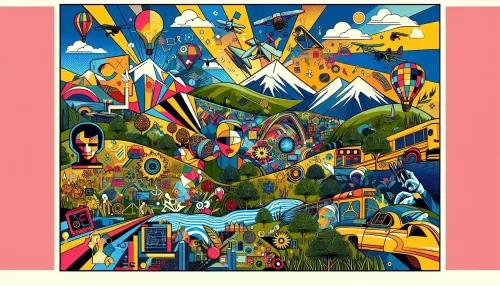
The Symphony of Sciences: Harmonizing Efforts in Autism Research and Therapy

Autism is a complex and multifaceted spectrum disorder that requires a holistic and multidisciplinary approach for comprehensive understanding and effective interventions. In recent years, the landscape of autism research and therapy has undergone a remarkable transformation as various scientific disciplines have converged to unlock new insights and possibilities. This harmonious collaboration, driven by the shared goal of improving the lives of autistic individuals, is shaping the future of autism care in profound ways.
A Unified Melody: How Biologists and Neuroscientists Are Joining Notes with Therapists
Traditionally siloed disciplines such as biology, neuroscience, and therapy are now finding common ground in the realm of autism research and therapy. Biologists delve deep into the genetic underpinnings of autism, uncovering invaluable clues about its etiology and potential therapeutic targets. Neuroscientists bring forth neurological perspectives, shedding light on the intricate workings of the autistic brain. Therapists, equipped with deep empathy and practical insights, bridge these scientific findings with real-world applications in supporting autistic individuals and their families.
The collaborative symphony orchestrated by these diverse expertise not only fosters a more profound understanding of autism but also paves the way for tailored interventions that honor the unique needs and strengths of each individual on the spectrum.
Cross-Pollination of Insights: The Impact of Collaborative Autism Studies Across Disciplines
The cross-pollination of insights from various scientific disciplines has yielded transformative outcomes in autism studies. For instance, the intersection of behavioral psychology with genetics has unveiled the interplay between genetic predispositions and behavioral manifestations in autism spectrum disorder. Similarly, the amalgamation of developmental psychology with neuroimaging techniques has offered unprecedented glimpses into the intricate developmental trajectories of autistic individuals' brains.
Such interdisciplinary collaborations not only enrich the scientific community's understanding of autism but also inspire innovative approaches to early detection, personalized interventions, and long-term support strategies.
Creating a New Language: The Integration of Computer Science in Understanding Autism
In an era propelled by technological advancements, the integration of computer science has emerged as a game-changer in deciphering the enigmatic facets of autism. From computational modeling of neural circuits implicated in social cognition to leveraging machine learning algorithms for predictive analytics based on behavioral patterns, computer science has elevated the precision and depth of autism research. Furthermore, virtual reality platforms are being harnessed to simulate social scenarios, offering valuable insights into the social challenges faced by autistic individuals.
The synergy between computer science and autism studies presents unprecedented opportunities to unravel hitherto inaccessible layers of the autistic experience, paving the way for more nuanced and effective interventions.
From Labs to Lives: Translating Scientific Discoveries Into Effective Autism Interventions
The true impact of multidisciplinary collaborations in autism research resonates in their ability to transcend laboratory findings into tangible improvements in the lives of autistic individuals. Insights gleaned from biological research are channeled into the development of targeted pharmacological interventions aimed at alleviating specific symptoms associated with autism. Meanwhile, neurological discoveries underpin the refinement of behavioral therapies tailored to enhance cognitive functioning and social interaction skills.
This translation from laboratory insights to impactful interventions epitomizes the power of collaborative efforts in creating meaningful differences in the daily experiences and long-term outcomes for individuals on the autism spectrum.
Collaborative Genius: Unleashing Potential Through United Efforts in Autism Research
The convergence of diverse scientific disciplines represents a testament to the collaborative genius driving autism research forward. By fostering an environment where biologists, neuroscientists, therapists, and computer scientists contribute synergistically to a shared body of knowledge, we witness breakthroughs that transcend the limitations of individual domains. The collective genius unravels complexities that would otherwise remain elusive and empowers us to envisage more holistic, effective, and person-centered strategies for supporting autistic individuals across their lifespan.
Orchestrating Success: Case Studies of Successful Multidisciplinary Projects for Autism
In examining successful multidisciplinary projects geared towards autism research and therapy, we encounter compelling narratives that underscore the transformative potential rooted in collaborative endeavors. From large-scale genome-wide association studies integrating input from geneticists, statisticians, and clinicians to community-based intervention programs blending expertise from educators, psychologists, and public health specialists, these case studies exemplify how harmonizing diverse skill sets leads to comprehensive solutions with far-reaching implications.
The orchestration of success through cohesive collaborations serves as a beacon illuminating the path towards more efficacious and inclusive approaches to autism care.
Bridging Disciplines for a Common Cause: The Journey Toward Revolutionary Autism Therapies
The journey towards revolutionary autism therapies unfolds as a tapestry woven with threads from disparate disciplines united by a common cause. As geneticists illuminate intricate genomic variations associated with autism susceptibility, behavior analysts decode nuanced behavioral patterns shaping individualized therapeutic strategies. Simultaneously, educators leverage pedagogical expertise to create inclusive learning environments tailored to accommodate diverse cognitive profiles among autistic students.
This seamless interplay among disciplines is charting new frontiers in autism therapy a testament to how collaboration transcends disciplinary boundaries for the betterment of autistic individuals' lives.
Synergy on the Spectrum: How Different Scientific Fields Are Advancing Autism Care Together
The synergy realized across different scientific fields is profoundly advancing autism care by fostering an ecosystem where collective knowledge propels innovation and compassion-driven solutions. As biologists unravel genetic predispositions intertwined with neurological intricacies underlined by neuroscientists' revelations, therapists harness this wealth of understanding to sculpt interventions rooted in empathy and evidence-based practices. Moreover, computer scientists fortify this alliance with groundbreaking technological applications designed to empower autistic individuals in navigating their social landscapes with increased confidence.
The synergy pulsating across scientific fields forms a harmonious ensemble a resounding tribute to how concerted efforts lead to meaningful strides in enhancing autism care holistically.
In conclusion, the collective efforts orchestrated through multidisciplinary collaborations resonate as a symphony an orchestration that harmonizes diverse scientific fields into a unified pursuit aimed at enhancing our understanding of autism and fostering transformative therapies. As each discipline contributes its unique notes to this melodic endeavour, we witness remarkable harmonies that transcend existing frontiers, amplifying hope and potential for autistic individuals worldwide.


